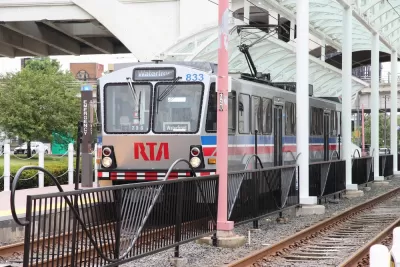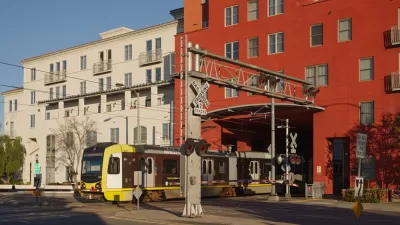The growth of transit-oriented development in the Cleveland region is being hindered by zoning codes that limit housing density and excessive parking requirements that drive up construction costs, new research suggests.

“New research by the Cuyahoga County Planning Commission offers fresh evidence that Cleveland and surrounding suburbs would be smart to rezone transit corridors to encourage dense, walkable, transit-oriented development, or TOD,” reports Steven Litt for Cleveland.com.
While market demand for transit-oriented development in Cleveland is growing, in many cases, developers still have to go through a cumbersome and expensive process to get permits to build TOD. “The data show that between 2012 and 2021, some 383 new developments added nearly $3 billion in real estate value through new construction or building renovations in the transit corridors.”While not every project is ‘transit-friendly,’ the study’s authors say “the new wave of development shows that to a significant extent, transit-oriented development is already happening in the core of the region because the market is demanding it.”
The research is part of an initiative to encourage transit-oriented development and assess how zoning changes can stimulate more housing production near transit lines. The four-phase project “will include identifying areas that could be targeted for transit-oriented development, drafting model codes, and identifying financial mechanisms and incentives.”
According to the study, the momentum for boosting development along transit in many Cleveland suburbs is stymied by outdated zoning codes and parking requirements, as well as disparate regulations among different suburbs. The authors suggest that Cuyahoga County could help suburbs develop their zoning plans with an eye to housing development, connectivity, and walkability. For its part, the county sees TOD as “an opportunity to add population and rebuild the tax base after decades of sprawl sapped its strength.”

Planetizen Federal Action Tracker
A weekly monitor of how Trump’s orders and actions are impacting planners and planning in America.

Maui's Vacation Rental Debate Turns Ugly
Verbal attacks, misinformation campaigns and fistfights plague a high-stakes debate to convert thousands of vacation rentals into long-term housing.

San Francisco Suspends Traffic Calming Amidst Record Deaths
Citing “a challenging fiscal landscape,” the city will cease the program on the heels of 42 traffic deaths, including 24 pedestrians.

Amtrak Rolls Out New Orleans to Alabama “Mardi Gras” Train
The new service will operate morning and evening departures between Mobile and New Orleans.

The Subversive Car-Free Guide to Trump's Great American Road Trip
Car-free ways to access Chicagoland’s best tourist attractions.

San Antonio and Austin are Fusing Into one Massive Megaregion
The region spanning the two central Texas cities is growing fast, posing challenges for local infrastructure and water supplies.
Urban Design for Planners 1: Software Tools
This six-course series explores essential urban design concepts using open source software and equips planners with the tools they need to participate fully in the urban design process.
Planning for Universal Design
Learn the tools for implementing Universal Design in planning regulations.
Heyer Gruel & Associates PA
JM Goldson LLC
Custer County Colorado
City of Camden Redevelopment Agency
City of Astoria
Transportation Research & Education Center (TREC) at Portland State University
Jefferson Parish Government
Camden Redevelopment Agency
City of Claremont





























